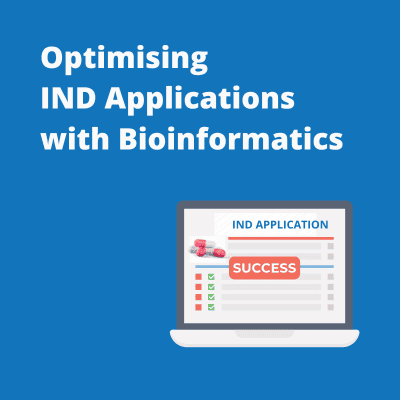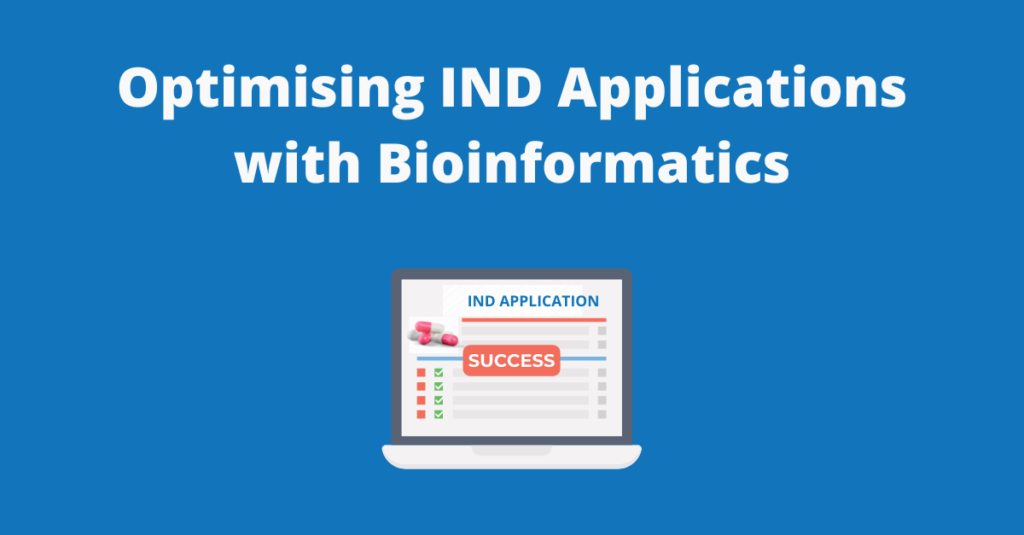Optimising IND Applications with Bioinformatics
- 14th March 2024
- Posted by: Breige McBride
- Category: Bioinformatics

Strategic use of bioinformatics approaches can be the difference between successful and unsuccessful Investigational New Drug (IND) applications. The U.S. Food and Drug Administration (FDA) requires drug developers to submit (and have approved) an IND application in order to receive authorisation to administer a new drug or biological product to humans. In simple terms, drug developers must have a successful IND application to begin human clinical trials of their new drug.
 The costs of preparing an IND application are considerable, in both time and resources. There are substantial costs associated with conducting preclinical experiments to gather relevant data, as well as the costs of conducting manufacturing studies to demonstrate that manufacturing processes would comply with regulatory standards. It is also common for companies preparing IND applications to hire consultants who have experience in writing IND applications. Then, there are all the administrative costs associated with the process, including an IND submission fee.
The costs of preparing an IND application are considerable, in both time and resources. There are substantial costs associated with conducting preclinical experiments to gather relevant data, as well as the costs of conducting manufacturing studies to demonstrate that manufacturing processes would comply with regulatory standards. It is also common for companies preparing IND applications to hire consultants who have experience in writing IND applications. Then, there are all the administrative costs associated with the process, including an IND submission fee.
What this all boils down to is, there is high incentive for drug developers to give their IND applications the best chance of being approved, first-time.
This is why using bioinformatics approaches throughout the IND application preparation process is vital, as demonstrated below.
IND Applications and Bioinformatics
Bioinformatics supports two of the three key areas that IND applications must cover; animal* pharmacology and toxicology studies and manufacturing information. The third area IND applications must cover is clinical protocols and investigator information.1 Bioinformatics analyses help ensure that the information in the application pertaining to the first two areas (animal pharmacology/toxicology studies and manufacturing information) is as robust as possible.
Using Bioinformatics in Animal Pharmacology and Toxicology Studies
Using bioinformatics in animal pharmacology and toxicology studies helps ensure the information relevant to these areas which is in included in your IND application, is well-evidenced. In turn, this gives your IND application a greater chance of being successful.
Animal pharmacology studies assess the safety of a potential drug and consider its ADME (Absorption; Distribution; Metabolism; and Excretion). Toxicology studies assess any harmful effects a potential drug could cause, as well as gather information relating to safe dosages.
Bioinformatics analyses can support animal pharmacology and toxicology studies in the following ways:
- Identifying and derisking off-target effects
- Identifying and derisking on-target off-tissue toxicity
- Assessing changes over time in animal models, via longitudinal biomarker analyses
- Providing insight into a therapeutic’s mode of action
Applying bioinformatics analyses to data gathered from toxicology studies can also provide context for up- and down-regulated genes. For example, such analyses can indicate whether a change in regulation could have harmful effects, or if there are associations that require further investigation. Bioinformatics can also be used to investigate PK/PD relationships that may also add weight to clinical protocol discussions.
Using Bioinformatics to Support the Manufacturing Information Required in IND Applications
When it comes to manufacturing information, the FDA requires IND applications for a potential drug to include information about:
- Drug composition
- The drug manufacturer
- Stability of the drug
- Controls used for manufacturing both the drug substance and the drug product2
All this information helps the FDA to assess a company’s ability to produce and supply consistent batches of the drug. Bioinformatics analyses can provide supporting evidence for information relating to a drug’s composition and stability.
For example, comparative analyses of data relating to multiple drug formulations can provide context and support for the formulation information ultimately included in the IND application. Also, for cell and gene therapy products, bioinformatics analyses can help with copy number and clonal analyses for manufacturing support.
Optimise Your IND Application with Bioinformatics
If you would like to give your IND application the best chance of success, contact us today to find out how we can support you with bioinformatics analyses. No matter what stage of the preclinical process you are in, we can assist with everything from identifying and verifying leads to providing analyses for manufacturing support. For 15 years, Fios Genomics has been supporting scientists, researchers and bioinformaticians in data analysis. We therefore have extensive experience in handling all types of datasets for drug discovery and development and a comprehensive understanding of the entire drug discovery and development process.
Author: Breige McBride, Content and Social Media Manager, Fios Genomics
Reviewed by Fios Genomics Bioinformatics Experts to ensure accuracy
Sources
1,2 https://www.fda.gov/drugs/types-applications/investigational-new-drug-ind-application
*New legislation, introduced in the U.S. in December 2022, enables the FDA to approve IND applications for companies to advance their drug candidates to human trials without prior animal studies, where scientifically justified. Currently, animal pharmacology and toxicology studies are still more common than not in IND applications.
See Also:
How to Reduce Animal Testing With Bioinformatics

